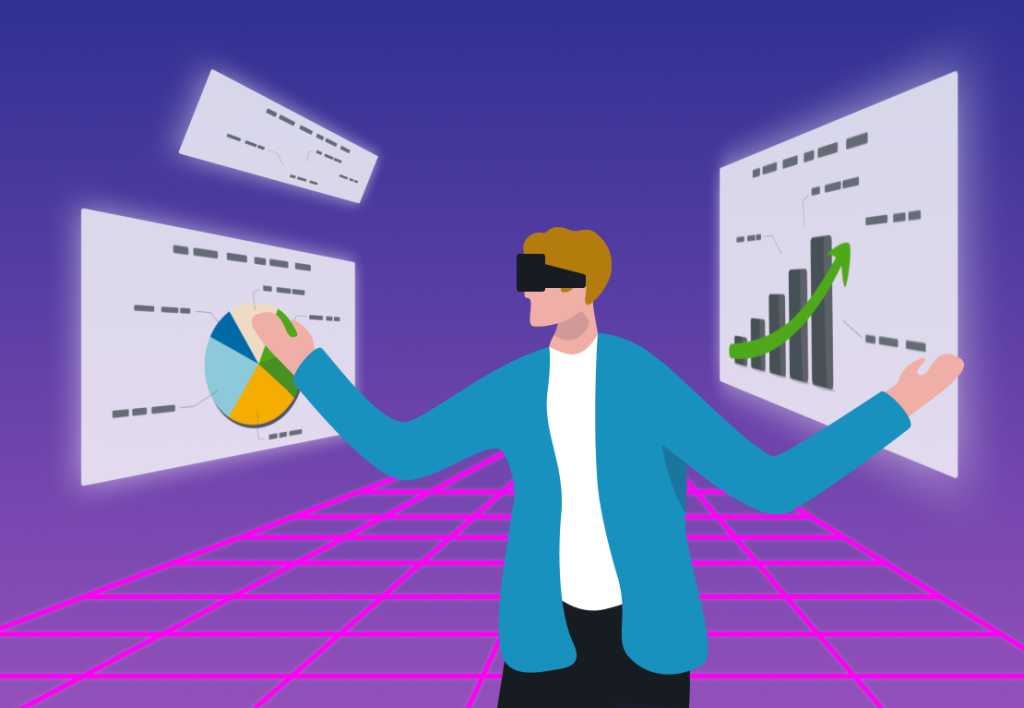Metaverse workplace – what the heck is it and who needs it?

One of the most talked about topics of 2022 was the Metaverse. Hailed as the next generation of the internet and communications, the ups and downs of the new technology headlined news media, conferences, and tech discussions worldwide.
Still, today, it remains little more than a buzzword, especially as it relates to the Metaverse workplace. The technology is still in its infancy and, despite a majority of employers signaling a willingness to adopt it, traction is negligible. Even Meta’s own employees have been reluctant to use their own product.
Want to get the most out of your time?
Try DeskTime for free!
Try free for 14 days · No credit card required.
By signing up, you agree to our terms and privacy policy.

That said, with remote and hybrid work becoming a staple of the modern work environment, a key part of the Metaverse’s promise is that it may help solve the most pervasive challenges faced by remote teams, namely, struggles with communication, collaboration, and loneliness. It would do so by providing an enhanced virtual space to connect and work.
But will it? What even is the Metaverse? And should you start planning for your very own Metaverse workplace in 2023?

What is the Metaverse workplace?
The Metaverse is a virtual reality (VR) space where people can connect as digital avatars to communicate and otherwise interact with each other. The virtual space can be anything – from an amusement park for socializing to an office room for meetings. Within this space, it’s possible to engage in a wide variety of activities, ranging from playing games to delivering presentations, and it unlocks a new way for distributed teams to come together, collaborate, and interact in real-time.
The promise of the Metaverse workplace is that it’s immersive, always active, and can be endlessly enhanced and molded to best suit your particular needs. To access it, all you need is a VR headset. But even that’s not mandatory, as you can enter these spaces from your smartphone – though it’ll make for a far less immersive and effective experience.
There are already a handful of valuable use cases for businesses, despite the technology being at a very early stage in development. To give some examples – in the virtual workplace Metaverse you can host meetings, run engaging seminars and training sessions, use it as a collaborative space, as well as leverage its fun aspects to shape a social space where distributed teams can come together to unwind and get to know each other. There’s a fun element to it all that should not be underrated – creating your avatar and exploring a new reality is thrilling and may lead to higher engagement.
All of the above are internal benefits, but there are external ones, too. The Metaverse may enhance your business meetings and sales processes, essentially making every connection in-person and personal. You can set up virtual booths or even entire worlds to showcase your product – the opportunities are endless.
But, given all these positives and use cases, why hasn’t the Metaverse workplace already become ubiquitous? After all, it’s been the talk of the town for a couple of years now.
7 reasons why the Metaverse WON’T be relevant for your business in 2023
You should definitely think twice before planning a hefty budget for headsets and Metaverse developers for 2023. Despite all the hype, there are several critical humps the Metaverse needs to get over regarding tech, adoption, and viability.
It’s unlikely 2023 will be the year of the Metaverse. Or 2024, for that matter. Here are 7 reasons why it’s too early to think about a Metaverse workplace.
1. It’s still in the early stages of development
One of the most notable Metaverse developments of 2022 was that avatars will have… legs. Not to take away from what is certainly an interesting and difficult technical challenge, but it’s not a game-changer for adoption.

Still in its early stages, the Metaverse is cartoonish, buggy, and limited in its functionality and usability. There is little reason to use it beyond having a chat with friends or colleagues, and, in that regard, physical reality is serving us just fine right now.
2. Requires significant infrastructure upgrades
The Metaverse uses a lot of data bandwidth and most homes and offices are not equipped to support it. Many look to 5G internet to support the Metaverse ecosystem, but its rollout is ongoing and far from ubiquitous. Meanwhile, in terms of connectivity, the world’s still dealing with frustrations about connection drops in Zoom calls.
Experts also suggest that 6G is required to take the Metaverse to the next level and unlock its incredible potential. The massively increased speed and reduced latency will enable real-time work with complex, high-definition elements, such as real-time translations, and allow the integration of virtually endless parallel features within any space. However, 6G is expected to arrive around 2030 – and that’s only early deployments. In other words, we’ve got at least a decade to go before the Metaverse levels up.
3. Not particularly useful for in-person teams
If the principal use case for a Metaverse workplace is to host meetings, then it makes little sense to adopt it for in-person teams. It’s doubtful that an in-person team will favor a digital whiteboard over a physical one. And it’s certainly easier to walk 10 steps to the meeting room than plug in a headset, login, and awkwardly navigate your way through digitally.
The pandemic may have solidified remote work as a core feature of the modern business world, but the majority of people continue to work in person or in a hybrid capacity. Metaverse adoption will struggle unless a solid reason emerges to favor it over in-person collaboration. Or, knock on wood, there’s another pandemic.
4. Virtual Reality sickness makes people queasy
VR sickness has been around long before the Metaverse. While there’s ongoing research about what exactly causes it and how to avoid it, the running theory is that VR glasses cause a sensory dissonance – your brain struggles to reconcile the visual input with your other sensory inputs. As a result, people quickly start feeling nausea, disorientation, sweating, and headaches

Over half of people experience it and women do so disproportionately. VR sickness may throw a wrench in the works for widespread adoption, as some people will find it simply impossible to hang out in the Metaverse for a prolonged period of time. It’s an issue that may be solved with better tech and more advanced setups. But, while we wait for those to arrive, inquire and test how your team responds to VR glasses, before mandating them for all.
5. Lack of use cases
Discussion surrounding the Metaverse is mostly focused on what it WILL be able to do. At the moment, however, workplace use cases boil down to various types of meetings. Admittedly, they do offer some advantages over simple conference calls, as you can gesticulate and interact more naturally with other participants – two things that people have reported to be a major shortcoming of Zoom calls.
But for the Metaverse to gain traction it needs to evolve well beyond a glorified meeting simulator. Or, at least, enhance the meeting experience to be more productive inside the Metaverse than outside of it. Still, as mentioned earlier, the novelty of it should not be underestimated and it may lead to certain productivity benefits in cases where it fosters engagement.
6. Nobody’s using it
Another major roadblock in Metaverse’s ascendance to widespread use is traction. Despite constant coverage in the media, the world isn’t particularly excited about the Metaverse, evidenced by the freefall of Meta’s share value. So, even if you were to shut your eyes on the previous points and decide to be a trendsetter, it would be an uphill battle.

For example, if you want to use the Metaverse to connect with potential clients or partners outside of your organization, they too would require the hardware and infrastructure to do so. There’s no point in creating a virtual showroom for your product if your clients can’t access it. Whereas, if you’re looking at it as an internal virtual space for your remote team – it may come at odds with the main reason why people want remote work, namely, flexibility. Digital nomads won’t be carrying a VR headset around anytime soon.
7. Hardware, training, and development are expensive
Last, but by no means least, it’s going to cost you. It’s one thing to simply buy the headsets (which are around $500 a pop), but you also need to invest in the infrastructure, environment, and training. Plus, the hardware is evolving rapidly, which means the current early headsets are likely to be outdated in a year or two.
This is just the hardware. If you’re looking to create personalized experiences and tailored virtual spaces within the Metaverse, you’ll either need to hire dedicated people or outsource the process to agencies. With what the Metaverse offers today, the ROI may be rather grim.

Boost your team’s productivity right now
Our all-in-one time management solution works wonders
The Metaverse workplace is not a game-changer… yet
Throughout 2023, you’ll be hearing a lot more about the Metaverse in news headlines, conferences, and tech discussions, but be skeptical of anyone who tells you that the Metaverse is here and everyone should use it. There are critical hurdles that must be overcome – and they probably won’t be in the coming years.
That said, the listed issues aren’t insurmountable. The basic ecosystem is there and we’re one extraordinary use case away from a massive spike in adoption. Still, barring a miracle, the development of the Metaverse will likely continue at a steady pace for the foreseeable future. So you don’t have to worry about your Metaverse workplace just yet, but definitely keep an eye out.
Did you find this article useful? Give it a clap!
Psst! You can clap more than once if you really loved it 🙂